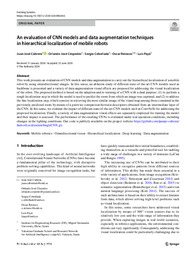Por favor, use este identificador para citar o enlazar este ítem:
https://hdl.handle.net/11000/32977Registro completo de metadatos
| Campo DC | Valor | Lengua/Idioma |
|---|---|---|
| dc.contributor.author | Cabrera, Juan José | - |
| dc.contributor.author | Céspedes, Orlando José | - |
| dc.contributor.author | Cebollada, Sergio | - |
| dc.contributor.author | Reinoso, Oscar | - |
| dc.contributor.author | Paya, Luis | - |
| dc.contributor.other | Departamentos de la UMH::Ingeniería de Sistemas y Automática | es_ES |
| dc.date.accessioned | 2024-09-06T08:45:41Z | - |
| dc.date.available | 2024-09-06T08:45:41Z | - |
| dc.date.created | 2024 | - |
| dc.identifier.citation | Evolving Systems, 2024 | es_ES |
| dc.identifier.issn | 1868-6486 | - |
| dc.identifier.uri | https://hdl.handle.net/11000/32977 | - |
| dc.description.abstract | This work presents an evaluation of CNN models and data augmentation to carry out the hierarchical localization of a mobile robot by using omnidirectional images. In this sense, an ablation study of diferent state-of-the-art CNN models used as backbone is presented and a variety of data augmentation visual efects are proposed for addressing the visual localization of the robot. The proposed method is based on the adaption and re-training of a CNN with a dual purpose: (1) to perform a rough localization step in which the model is used to predict the room from which an image was captured, and (2) to address the fne localization step, which consists in retrieving the most similar image of the visual map among those contained in the previously predicted room by means of a pairwise comparison between descriptors obtained from an intermediate layer of the CNN. In this sense, we evaluate the impact of diferent state-of-the-art CNN models such as ConvNeXt for addressing the proposed localization. Finally, a variety of data augmentation visual efects are separately employed for training the model and their impact is assessed. The performance of the resulting CNNs is evaluated under real operation conditions, including changes in the lighting conditions. | es_ES |
| dc.format | application/pdf | es_ES |
| dc.format.extent | 13 | es_ES |
| dc.language.iso | eng | es_ES |
| dc.publisher | Springer | es_ES |
| dc.rights | info:eu-repo/semantics/openAccess | es_ES |
| dc.rights | Attribution-NonCommercial-NoDerivatives 4.0 Internacional | * |
| dc.rights.uri | http://creativecommons.org/licenses/by-nc-nd/4.0/ | * |
| dc.subject | Mobile robotics | es_ES |
| dc.subject | Omnidirectional vision | es_ES |
| dc.subject | Hierarchical localization | es_ES |
| dc.subject | Deep learning | es_ES |
| dc.subject | Data augmentation | es_ES |
| dc.subject.other | CDU::6 - Ciencias aplicadas::62 - Ingeniería. Tecnología | es_ES |
| dc.title | An evaluation of CNN models and data augmentation techniques in hierarchical localization of mobile robots | es_ES |
| dc.type | info:eu-repo/semantics/article | es_ES |
| dc.relation.publisherversion | https://doi.org/10.1007/s12530-024-09604-6 | es_ES |

Ver/Abrir:
s12530-024-09604-6.pdf
1,68 MB
Adobe PDF
Compartir:
 La licencia se describe como: Atribución-NonComercial-NoDerivada 4.0 Internacional.
La licencia se describe como: Atribución-NonComercial-NoDerivada 4.0 Internacional.
.png)